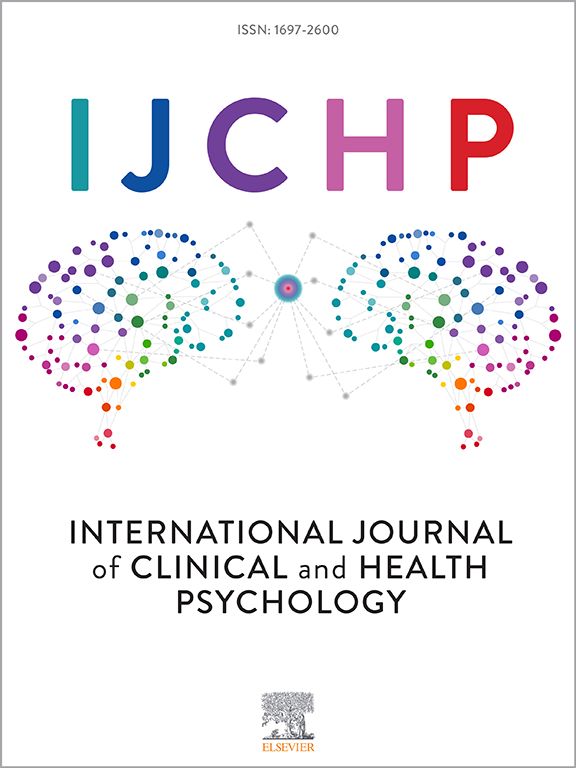Sleep disturbances in early adolescents and risk of later suicidality: A national prospective cohort study
IF 4.4
1区 心理学
Q1 PSYCHOLOGY, CLINICAL
International Journal of Clinical and Health Psychology
Pub Date : 2025-04-01
DOI:10.1016/j.ijchp.2025.100580
引用次数: 0
Abstract
Introduction
Sleep disturbances have been linked to later suicidality among adolescents. This study assessed the associations between sleep disturbances experienced at age 11 and the subsequent occurrence of suicide thoughts and suicide attempt measured at age 18.
Methods
Self-reported data on sleep disturbances measured at age 11 was obtained from the Danish National Birth Cohort and linked to information on suicidality at age 18 based on self-reports and register-based data on hospital contacts for suicide attempt. Relative risk ratios(RRR) with corresponding 95 % confidence intervals were estimated using multivariable multinomial logistic regressions adjusting for sex, sociodemographic characteristics, psychiatric history, and child risk behaviors and procedures of inverse probability weighting were applied .
Results
A total of 28,251 participants were included, of whom 8894 (32.0 %) reported suicide thoughts and 743 (3.3 %) attempted suicide at age 18. Adolescents who at age 11 reported sleeping <8 hours per night had elevated risk of suicide thoughts (aRRR, 1.7; 95 % CI, 1.3–2.1) and suicide attempt (aRRR, 3.7; 95 % CI, 2.6–5.4) when compared with those sleeping ≥9 hours. Going to bed after 10:30PM versus before 9:00PM on weekdays was associated with higher risks of suicide thoughts (aRRR, 1.6; 95 % CI, 1.3–2.0) and suicide attempt (aRRR, 3.3; 95 % CI, 2.3–4.9). Dose-response relationships documented that experiencing difficulties falling asleep more often was associated with higher risks of suicide thoughts and suicide attempts. Adjusting for child psychiatric co-morbidity attenuated results, however associations still showed statistical significance.
Conclusion
Sleep disturbances were associated with later suicidality among adolescents. Significant associations suggested that adequate hours of sleep and earlier bedtimes might protect against suicidality in children and adolescents.
青少年早期睡眠障碍与后期自杀风险:一项全国前瞻性队列研究
在青少年中,睡眠障碍与后来的自杀行为有关。这项研究评估了11岁时经历的睡眠障碍与随后18岁时自杀念头和自杀企图之间的联系。方法从丹麦国家出生队列中获得11岁时测量的自我报告的睡眠障碍数据,并将其与18岁时基于自我报告和自杀未遂医院联系记录的自杀信息联系起来。采用多变量多项式logistic回归,对性别、社会人口学特征、精神病史、儿童危险行为等因素进行校正,估算出相应95%置信区间的相对风险比(RRR)。结果共纳入28,251名参与者,其中8894名(32.0%)报告有自杀念头,743名(3.3%)在18岁时自杀未遂。11岁时报告每晚睡8小时的青少年有更高的自杀念头风险(aRRR, 1.7;95% CI, 1.3-2.1)和自杀企图(aRRR, 3.7;95% CI, 2.6-5.4),与睡眠时间≥9小时者相比。在工作日晚上10:30之后上床睡觉与晚上9:00之前相比,自杀念头的风险更高(aRRR, 1.6;95% CI, 1.3-2.0)和自杀企图(aRRR, 3.3;95% ci, 2.3-4.9)。剂量-反应关系表明,入睡困难的频率越高,自杀念头和自杀企图的风险越高。对儿童精神疾病合并症进行调整后,结果减弱,但相关仍显示有统计学意义。结论睡眠障碍与青少年后期自杀行为有关。重要的关联表明,充足的睡眠时间和较早的就寝时间可以防止儿童和青少年自杀。
本文章由计算机程序翻译,如有差异,请以英文原文为准。
求助全文
约1分钟内获得全文
求助全文
来源期刊

International Journal of Clinical and Health Psychology
PSYCHOLOGY, CLINICAL-
CiteScore
10.70
自引率
5.70%
发文量
38
审稿时长
33 days
期刊介绍:
The International Journal of Clinical and Health Psychology is dedicated to publishing manuscripts with a strong emphasis on both basic and applied research, encompassing experimental, clinical, and theoretical contributions that advance the fields of Clinical and Health Psychology. With a focus on four core domains—clinical psychology and psychotherapy, psychopathology, health psychology, and clinical neurosciences—the IJCHP seeks to provide a comprehensive platform for scholarly discourse and innovation. The journal accepts Original Articles (empirical studies) and Review Articles. Manuscripts submitted to IJCHP should be original and not previously published or under consideration elsewhere. All signing authors must unanimously agree on the submitted version of the manuscript. By submitting their work, authors agree to transfer their copyrights to the Journal for the duration of the editorial process.
 求助内容:
求助内容: 应助结果提醒方式:
应助结果提醒方式:


